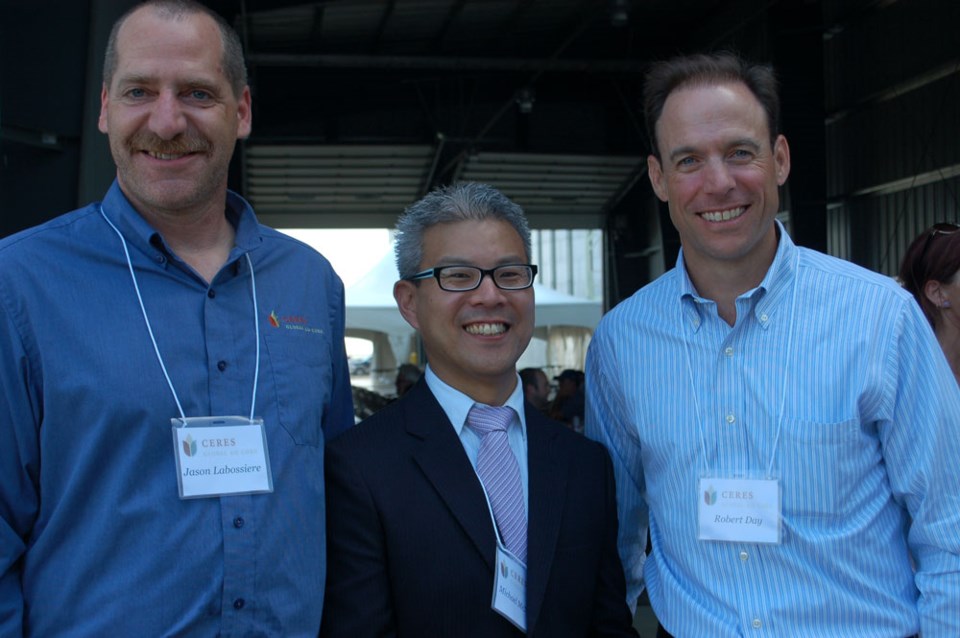Although it may not be considered over the top by today’s standards that call for anything and everything to be huge in stature, the Ceres commodities terminal that sits nextdoor to the tiny hamlet of Northgate, Saskatchewan that happens to be conveniently perched on the Canada/U.S. border, is still mammothly impressive.
It was impressive enough to attract the company’s newly appointed president and CEO from Toronto, to an official launching on July 20, following the completion of construction on the massive storage and shipping terminal that can hold up to 2.7 million bushels of agricultural products.
What makes the terminal unique is that it is the only Canadian hub served directly by an American rail line, Burlington Northern Santa Fe (BNSF), and with a dedicated customs office and direct links to U.S., as well as South American and European markets.
“We can load up to 80,000 bushels an hour,” said Curt Larsen, the company’s regional manager. The shuttle loading, double drive-way capabilities will allow Ceres to ramp up their daily railcar loading pace, when required, said Jason Labossiere, the Northgate grains origination manager.
“We see our client base growing, along with our product lines,” Labossiere said, referring to the hub that not only can load and ship typical agricultural commodities such as durum, wheat, oats, canola, rye, flax and yellow peas, for instance, but also propane, and crude oil, through a separate but neighbouring set of logistical equipment and rail tracks that run parallel to the tracks that bring the BNSF trains in and out of Northgate on a regular schedule. In return, shipments of U.S. commodities, such as fertilizers, find their way onto the trains entering Canada at Northgate, where they are unloaded and stored in a separate facility prior to dispersal into the marketplace.
Day and Labossiere said that at first Ceres thought their geographical sphere of influence would extend to, perhaps, 100 kilometres, but they have since discovered that producers from as far away as 150 kilometres have trucked their way to the Northgate facility.
The company recently closed down one of their major holding terminals in Duluth Minn., but Day said that decision was not based on anything that was happening in southern Saskatchewan, but rather on a need to provide more efficiencies for their overseas shipping operations. Much of the Northgate product will find its way to and through Duluth.
Barbara Haertling, general director of wheat for BNSF was present at the launching in Northgate but was unable to speak with Agri News as an official spokeswoman for the railway. Day and Labossiere said, however, the working relationship between the terminal and the railway has been genuinely positive to date, with Ceres using the oil and propane loading facilities for shipping between 150 to 180 railcars a month from a Canadian supplier, into the U.S. They expect that when crude oil prices recover, perhaps closer to $55 per barrel, Canadian producers will be ready to use their facility for shipping oil by rail to tidewater, thus expanding the market reach.
“The BNSF service has been provided on par and their service has met our expectations with timely arrivals for shipping,” said Labossiere.
International money exchange rates ( i.e. Canada-U.S. dollars) are part of the risk management and trading system that is handled by the origination team.
“There are different challenges for various commodities and because we are the first in Canada served directly by U.S. rail, there are new challenges but nothing that is not normal,” said Day. “It seems BNSF can get Canadian product to the market just as competitively as their Canadian rail counterparts,” Day said, adding that the rail and trading partnership allows them to think globally and be aware of emerging opportunities for their customers whether they be oil and gas industry related, or as the agricultural grain price taker and owner of those commodities.
“To date we’re ahead of matters for the breadth of the market and the volumes we are selling,” said Day, who suggested that as time progresses, the company will be fielding and shipping not only yellow peas but also lentils and other agricultural products to anxious markets.
Jared Kornkven, a farmer from the Alameda area who attended the official launching along with about 400 other guests, said he has been shipping spring wheat, winter wheat and canola through Northgate ever since it opened with a temporary transloading system a year earlier. “I’m very happy with their unloading capacity, prices, service and storage. I figure I’m pretty lucky to have this right on my doorstep,” he said, commenting on the fact that the terminal is located not far from that community, and close to the town of Oxbow and the City of Estevan.



